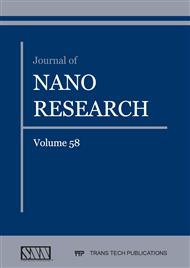[1]
C.F.E., Summary of failures in transmission lines 2010-2014, México, D.F., 2015 (in Spanish).
Google Scholar
[2]
C.F.E., Outages, Statistics, and Relevant Works in Transmission Lines 2011, México, D.F., January 2012 (in Spanish).
Google Scholar
[3]
C.F.E., Annual Report 2011, México, D.F., 2011 (in Spanish).
Google Scholar
[4]
C.F.E., Report of the Federal Public Administration 2006–2012, México, D.F., 2013 (in Spanish).
Google Scholar
[5]
J.M. Tobias, The basis of conventional lightning protection systems, IEEE Transactions on Industry Applications. 40 (2004) 958- 962.
DOI: 10.1109/tia.2004.831277
Google Scholar
[6]
T.T. Nguyen and R. Holt, Lightning protection of transmission lines: optimal shielding design procedure, IEE Proceedings-Generation, Transmission and Distribution. 150 (2003) 659-667.
DOI: 10.1049/ip-gtd:20030819
Google Scholar
[7]
W.A. Chisholm, E. Petrache and F. Bologna, Grounding of overhead transmission lines for improved lightning protection, IEEE PES Transmission and Distribution Conference and Exposition. , (2010) 1-6.
DOI: 10.1109/tdc.2010.5484321
Google Scholar
[8]
K. Munukutla, V. Vittal, G.T. Heydt, D. Chipman and B. Keel, A practical Evaluation of Surge Arrester Placement for Transmission Line Lightning Protection, IEEE Transactions on Power Delivery. 25 (2010) 1742-1748.
DOI: 10.1109/tpwrd.2010.2040843
Google Scholar
[9]
F. Zhenghua, L. Ling and F. Junzhong, Research on reducing grounding resistance of transmission line tower grounding grid. International Conference on Electrical and Control Engineering (ICECE) (2011) 1216–1219.
DOI: 10.1109/iceceng.2011.6057902
Google Scholar
[10]
V. P. Androvitsaneas, I. F. Gonos, I. A. Stathopulos, Performance of Ground Enhancing Compounds During the Year, International Conference on Lightning Protection (ICLP). (2012) Vienna, Austria.
DOI: 10.1109/iclp.2012.6344356
Google Scholar
[11]
W.F. Wan Ahmad, M. S. Abdul Rahman, J. Jasni, M. Z. A. Ab Kadir and H. Hizam, Chemical Enhancement Materials for Grounding Purposes. 30th International Conference on Lightning Protection (ICLP), (2010) 1106-1, 1106-6, Cagliari, Italy.
DOI: 10.1109/iclp.2010.7845836
Google Scholar
[12]
Y. Zhu, S. Murali, W. Cai, X. Li, J.W. Suk, J.R. Potts and R.S. Ruoff, Graphene and Graphene Oxide: Synthesis, Properties, and Applications. Advanced Materials 22 (2010) 3906–3924.
DOI: 10.1002/adma.201001068
Google Scholar
[13]
Z.S. Wu, G. Zhou, L.C. Yin, W. Ren, F. Li, H.M. Cheng, Graphene/metal oxide composite electrode materials for energy storage. Nano Energy 1 (2012) 107–131.
DOI: 10.1016/j.nanoen.2011.11.001
Google Scholar
[14]
K.S. Novoselov, V.I. Falko, L. Colombo, P.R. Gellert, M.G. Schwab and K. Kim, A roadmap for graphene. Nature 490 (2012) 192-200.
DOI: 10.1038/nature11458
Google Scholar
[15]
D. Krishnan, F. Kim, J. Luo, R. Cruz-Silva, L.J. Cote, H.D. Jang and J. Huang, Energetic graphene oxide: Challenges and opportunities. Nano Today 7 (2012)137-152.
DOI: 10.1016/j.nantod.2012.02.003
Google Scholar
[16]
ASTM G 187-05, Standard Test Method for Measurement of Soil Resistivity Using the Two-Electrode Soil Box Method (2005).
DOI: 10.1520/g0187
Google Scholar
[17]
S. Sumathi and S. Paneerselvam, Computational intelligence paradigms: theory & applications using MATLAB, 1st Ed., Taylor & Francis Group, Florida, (2010).
Google Scholar
[18]
S. Samarasinghe, Neural networks for applied sciences and engineering: from fundamentals to complex pattern recognition, 1st Ed.,Taylor & Francis Group, Florida, (2007).
Google Scholar
[19]
T. Lin, B. G. Horne, P. Tiño and C.L. Giles, Learning long-term dependencies in NARX recurrent neural networks, IEEE Trans. on Neural Networks. 7 (1996) 1329-1338.
DOI: 10.1109/72.548162
Google Scholar
[20]
F.D. Foresee and M.T. Hagan, Gauss-Newton approximation to Bayesian regularization. Proc. International Joint Conference on Neural Networks (1997) 1930-1935.
DOI: 10.1109/icnn.1997.614194
Google Scholar
[21]
K. Narendra and K. Parthasarathy, Identification and control of dynamic systems using neural networks, IEEE Trans. on Neural Networks. 1 (1990) 4-27 (1990).
DOI: 10.1109/72.80202
Google Scholar


